The Bone Metabolism Test Market is estimated to be valued at USD 3.1 billion in 2025 and is projected to reach USD 6.5 billion by 2035, registering a compound annual growth rate (CAGR) of 7.5% over the forecast period.
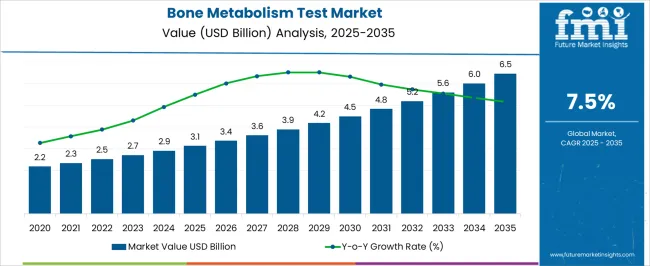
| Metric | Value |
|---|---|
| Bone Metabolism Test Market Estimated Value in (2025 E) | USD 3.1 billion |
| Bone Metabolism Test Market Forecast Value in (2035 F) | USD 6.5 billion |
| Forecast CAGR (2025 to 2035) | 7.5% |
The Bone Metabolism Test market is growing steadily, fueled by the increasing prevalence of bone-related disorders such as osteoporosis, osteopenia, and metabolic bone disease, particularly among the aging population. Rising awareness of early diagnosis and preventive healthcare is encouraging both patients and healthcare providers to adopt advanced diagnostic tests for monitoring bone health. Technological advancements in diagnostic testing, including biomarker-based assays and imaging enhancements, are improving accuracy and enabling personalized treatment planning.
Growing investments in healthcare infrastructure, coupled with the expansion of specialized diagnostic centers, are further strengthening market penetration. Increasing healthcare expenditure and the rising demand for non-invasive and efficient testing solutions are shaping the market trajectory. In addition, favorable reimbursement policies in developed regions and government-led initiatives promoting preventive healthcare are supporting adoption.
The global shift toward preventive diagnostics, particularly for women at risk of post-menopausal osteoporosis, highlights the importance of bone metabolism tests With the growing burden of skeletal disorders, the market is poised to expand significantly, supported by continuous technological innovation and the increasing emphasis on population-wide screening programs.
The bone metabolism test market is segmented by test types, application types, end users, and geographic regions. By test types, bone metabolism test market is divided into Bone Marker Test, C-Telopeptide Marker Test, P1NP Marker Test, N-Telopeptide Marker Test, Osteocalcin Test, Others, Immunoassay, ELISA, and RIA. In terms of application types, bone metabolism test market is classified into Osteoporosis, Hyperparathyroidism, Hypoparathyroidism, Paget's Disease, and Kidney Disease. Based on end users, bone metabolism test market is segmented into Hospitals, Reference Laboratories, Specialty Clinics, and Other. Regionally, the bone metabolism test industry is classified into North America, Latin America, Western Europe, Eastern Europe, Balkan & Baltic Countries, Russia & Belarus, Central Asia, East Asia, South Asia & Pacific, and the Middle East & Africa.
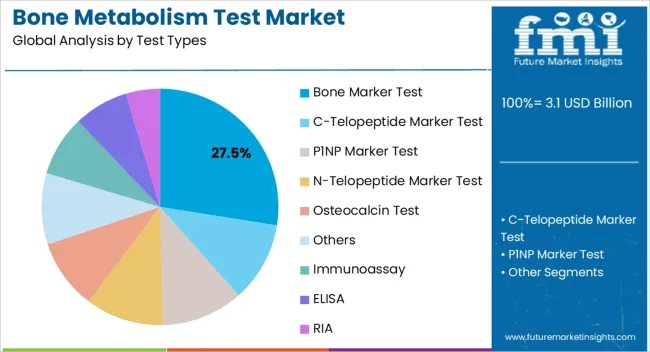
The bone marker test segment is projected to hold 27.5% of the Bone Metabolism Test market revenue in 2025, making it the leading test type. Growth is being driven by the segment’s ability to detect biochemical markers that provide early insights into bone turnover and metabolic activity. These tests play a critical role in assessing the effectiveness of treatment regimens for osteoporosis and other metabolic bone disorders.
The growing demand for precision medicine and real-time monitoring of bone health is enhancing adoption of these tests across hospitals and specialized diagnostic centers. Advances in biomarker identification and assay sensitivity are improving diagnostic reliability, further strengthening clinical utility.
The convenience of blood or urine-based sample collection is making these tests more accessible to patients, while integration with electronic health records allows for seamless monitoring of disease progression As healthcare providers continue to emphasize early intervention and outcome-based treatment planning, bone marker tests are expected to remain a cornerstone in diagnostic strategies, maintaining their leadership in the market.
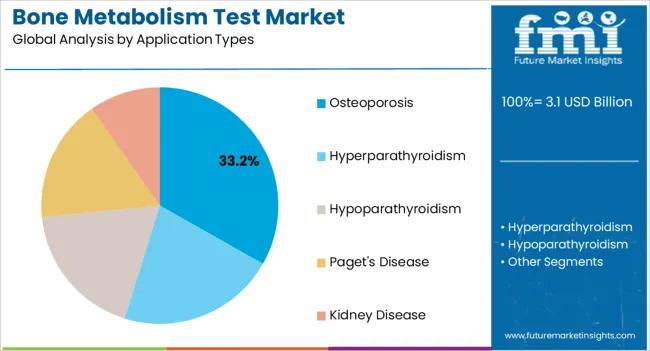
The osteoporosis application segment is anticipated to account for 33.2% of the Bone Metabolism Test market revenue in 2025, underscoring its dominant role in clinical practice. The rising prevalence of osteoporosis, particularly among post-menopausal women and elderly populations, is creating strong demand for reliable diagnostic tools. Bone metabolism tests are increasingly used to identify patients at high risk of fractures and to monitor treatment efficacy during long-term therapy.
Public health campaigns and government-led initiatives focused on osteoporosis awareness and early detection are accelerating adoption rates. Advances in test sensitivity and the integration of biomarker-based diagnostics with imaging modalities are improving patient outcomes, enabling more targeted interventions. Healthcare providers are adopting these tests not only for diagnosis but also for monitoring adherence to prescribed treatments.
The economic burden of osteoporosis-related fractures is significant, further reinforcing the need for preventive diagnostics With the global population aging rapidly, the osteoporosis segment is expected to remain the largest application area, driven by clinical necessity and continuous innovation in diagnostic technologies.
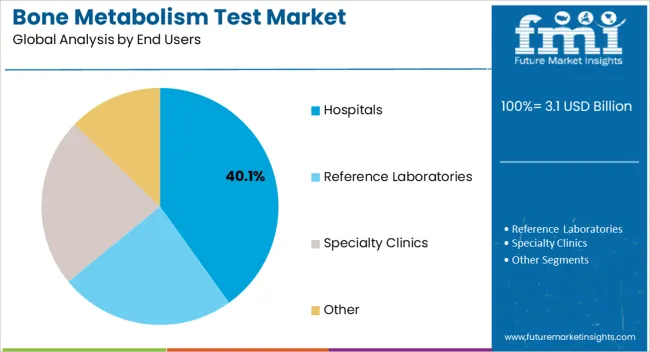
The hospitals segment is expected to capture 40.1% of the Bone Metabolism Test market revenue in 2025, positioning it as the leading end user. Hospitals are increasingly serving as the primary centers for comprehensive diagnostic services, offering advanced facilities and integrated care pathways for patients with bone health concerns. The availability of specialized diagnostic departments, coupled with skilled medical professionals, enhances the reliability of hospital-based testing.
Hospitals also act as referral centers for patients requiring further evaluation or treatment for osteoporosis and other metabolic bone diseases. The adoption of bone metabolism tests in hospitals is being reinforced by the increasing demand for preventive care, inpatient management, and post-fracture assessments. Integration with advanced laboratory infrastructure and electronic health systems allows for efficient data management and patient monitoring.
Reimbursement support for hospital-based diagnostics is further driving uptake, especially in developed regions As healthcare systems focus on early detection and cost-effective management of chronic conditions, hospitals are expected to remain the leading end users, solidifying their dominant position in the market.
Conflicting to the repeatedly held misinterpretations, bone is a comparatively active organ that experience notable changes as contrast to other organs in the body. Bone metabolism is related with diseases impacting bone and mineral metabolism that includes a wide range of skeletal and soft tissue infection.
In general, these infections may be combined as Paget disease of bone, osteoporosis, developmental disorders of bone and hyperparathyroidism. Geriatric population that is nearby 28 million in America get influenced by osteoporosis, and the fetch to treat for osteoporosis-associated fractures was evaluated to be about $14.8 billion every year a short time before.
Other metabolic bone diseases are comparatively lacking, but anyhow are a source of notable cost to society and morbidity. Bone is a specific tissue intended to deliver enough potency to resist involuntary forces, but still to be light enough to permit flexibility. It has a complicated composition and experience constant remodeling or metabolism.
To treat bone metabolism diseases there are several tests available in market and cost for treatment is much higher as most of the population in the world is threatened by bone metabolism diseases the market will drive towards growth for bone metabolism tests.
On the basis of test types global bone metabolism test market can be segmented into bone marker test and immunoassay where, bone markers are related with biochemical marker that specify breakdown of bone that can be used to estimate individual’s bone fracture risk at the moment when density of mineral measurement does not specify the results and immunoassay is related with a laboratory technique that recognize and evaluate a protein like hormone or enzyme based on capacity to act as an antibody or antigen in chemical reaction.
Furthermore, Bone marker tests are categorized into C-Telopeptide marker test, P1NP marker test, N- telopeptide marker test and osteocalcin test. C-Telopeptide marker test used to monitor anti-restoratives therapies like hormone replacement therapy in people with low bone mass and in women with menopause and is peptide fragment from the carboxyl terminal end of the protein matrix. P1NP Marker is for bone formation occurred from osteoblast and it is recommended that the test should be performed before the treatment of osteoporosis and again after 3 to 6 months.
N-telopeptide is a peptide fragment used to monitor another marker therapy from amino terminal end of the protein matrix and osteocalcin is form of protein formed by osteoblast this test may be simulated by using drug warfarin. Moreover, Immunoassay is categorized into ELISA and RIA where enzyme-linked immunosorbent assay (ELISA) is used to detect the presence of antibody and antigen through a biochemical mechanism and radioimmunoassay (RIA) is in-vitro assay technique to detect antigen in the body with the help of antibody present in the body.
On the basis of application types global bone metabolism test market is segmented into hyperparathyroidism, hypoparathyroidism, osteoporosis, Paget’s disease and kidney disease. Hyperparathyroidism mostly occur in people having age more than 50 while neonatal or new born babies are highly threatened by hypoparathyroidism.
Osteoporosis has dominated the market in bone metabolism diseases and is the most common disease occurring in women on in tenth will have osteoporosis at the age of 60, more than 8.9 million fractures are recorded yearly due to osteoporosis throughout the world. Rising penetrance rate of osteoporosis is driving the bone metabolism test market towards the growth in the forecast period. Paget’s disease is most common in men than women in that bone growth is too large and weak.
On the basis of geography, global bone metabolism test market is segmented into five key regions: North America, Latin America, Europe, Asia Pacific and Middle East Africa.
North America and Latin America are the dominating market in global bone metabolism test market followed by Europe as penetrance of osteoporosis, hyperparathyroidism is increasing in large amount. Asia pacific and Middle East Africa is rising market for bone metabolism test market as volume has increased in last few years. Hence, companies are making strategies to enter in the market.
Some of the major players in global metabolism test market are: Siemens Healthcare GmbH, F. Hoffmann-La Roche, Abbott GmbH & Co. KG, DiaSorin, bioMerieux SA and Quidel Corporation. Siemens Healthcare GmbH Has largest market share in bone metabolism test market. The increasing competition in key players to develop new therapy and technology for bone metabolism test will drive the market globally.
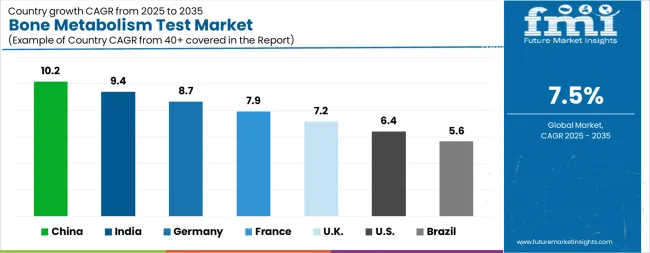
| Country | CAGR |
|---|---|
| China | 10.2% |
| India | 9.4% |
| Germany | 8.7% |
| France | 7.9% |
| UK | 7.2% |
| USA | 6.4% |
| Brazil | 5.6% |
The Bone Metabolism Test Market is expected to register a CAGR of 7.5% during the forecast period, exhibiting varied country level momentum. China leads with the highest CAGR of 10.2%, followed by India at 9.4%. Developed markets such as Germany, France, and the UK continue to expand steadily, while the USA is likely to grow at consistent rates. Brazil posts the lowest CAGR at 5.6%, yet still underscores a broadly positive trajectory for the global Bone Metabolism Test Market. In 2024, Germany held a dominant revenue in the Western Europe market and is expected to grow with a CAGR of 8.7%. The USA Bone Metabolism Test Market is estimated to be valued at USD 1.1 billion in 2025 and is anticipated to reach a valuation of USD 2.0 billion by 2035. Sales are projected to rise at a CAGR of 6.4% over the forecast period between 2025 and 2035. While Japan and South Korea markets are estimated to be valued at USD 163.3 million and USD 100.3 million respectively in 2025.
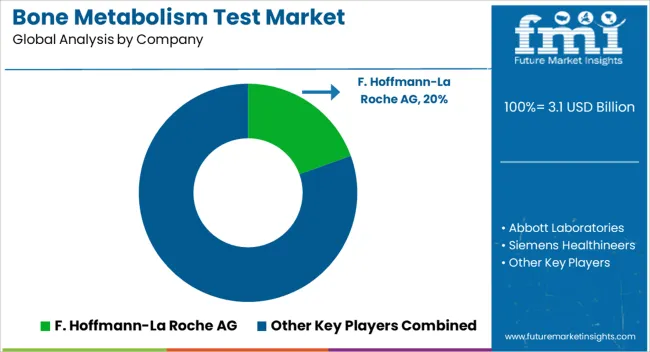
| Item | Value |
|---|---|
| Quantitative Units | USD 3.1 Billion |
| Test Types | Bone Marker Test, C-Telopeptide Marker Test, P1NP Marker Test, N-Telopeptide Marker Test, Osteocalcin Test, Others, Immunoassay, ELISA, and RIA |
| Application Types | Osteoporosis, Hyperparathyroidism, Hypoparathyroidism, Paget's Disease, and Kidney Disease |
| End Users | Hospitals, Reference Laboratories, Specialty Clinics, and Other |
| Regions Covered | North America, Europe, Asia-Pacific, Latin America, Middle East & Africa |
| Country Covered | United States, Canada, Germany, France, United Kingdom, China, Japan, India, Brazil, South Africa |
| Key Companies Profiled | F. Hoffmann-La Roche AG, Abbott Laboratories, Siemens Healthineers, Bio-Rad Laboratories, Inc., Ortho Clinical Diagnostics, DiaSorin S.p.A., Beckman Coulter, Inc., and Quidel Corporation |
The global bone metabolism test market is estimated to be valued at USD 3.1 billion in 2025.
The market size for the bone metabolism test market is projected to reach USD 6.5 billion by 2035.
The bone metabolism test market is expected to grow at a 7.5% CAGR between 2025 and 2035.
The key product types in bone metabolism test market are bone marker test, c-telopeptide marker test, p1np marker test, n-telopeptide marker test, osteocalcin test, others, immunoassay, ELISA and ria.
In terms of application types, osteoporosis segment to command 33.2% share in the bone metabolism test market in 2025.






Our Research Products

The "Full Research Suite" delivers actionable market intel, deep dives on markets or technologies, so clients act faster, cut risk, and unlock growth.

The Leaderboard benchmarks and ranks top vendors, classifying them as Established Leaders, Leading Challengers, or Disruptors & Challengers.

Locates where complements amplify value and substitutes erode it, forecasting net impact by horizon

We deliver granular, decision-grade intel: market sizing, 5-year forecasts, pricing, adoption, usage, revenue, and operational KPIs—plus competitor tracking, regulation, and value chains—across 60 countries broadly.

Spot the shifts before they hit your P&L. We track inflection points, adoption curves, pricing moves, and ecosystem plays to show where demand is heading, why it is changing, and what to do next across high-growth markets and disruptive tech

Real-time reads of user behavior. We track shifting priorities, perceptions of today’s and next-gen services, and provider experience, then pace how fast tech moves from trial to adoption, blending buyer, consumer, and channel inputs with social signals (#WhySwitch, #UX).

Partner with our analyst team to build a custom report designed around your business priorities. From analysing market trends to assessing competitors or crafting bespoke datasets, we tailor insights to your needs.
Supplier Intelligence
Discovery & Profiling
Capacity & Footprint
Performance & Risk
Compliance & Governance
Commercial Readiness
Who Supplies Whom
Scorecards & Shortlists
Playbooks & Docs
Category Intelligence
Definition & Scope
Demand & Use Cases
Cost Drivers
Market Structure
Supply Chain Map
Trade & Policy
Operating Norms
Deliverables
Buyer Intelligence
Account Basics
Spend & Scope
Procurement Model
Vendor Requirements
Terms & Policies
Entry Strategy
Pain Points & Triggers
Outputs
Pricing Analysis
Benchmarks
Trends
Should-Cost
Indexation
Landed Cost
Commercial Terms
Deliverables
Brand Analysis
Positioning & Value Prop
Share & Presence
Customer Evidence
Go-to-Market
Digital & Reputation
Compliance & Trust
KPIs & Gaps
Outputs
Full Research Suite comprises of:
Market outlook & trends analysis
Interviews & case studies
Strategic recommendations
Vendor profiles & capabilities analysis
5-year forecasts
8 regions and 60+ country-level data splits
Market segment data splits
12 months of continuous data updates
DELIVERED AS:
PDF EXCEL ONLINE
Bone Defect Repair Materials Market Size and Share Forecast Outlook 2025 to 2035
Test and Measurement Equipment Market Size and Share Forecast Outlook 2025 to 2035
Bone Morphogenetic Protein Market Size and Share Forecast Outlook 2025 to 2035
Testosterone Test Market Size and Share Forecast Outlook 2025 to 2035
Test rig Market Size and Share Forecast Outlook 2025 to 2035
Bone Health Supplement Market Size and Share Forecast Outlook 2025 to 2035
Test and Measurement Sensors Market Size and Share Forecast Outlook 2025 to 2035
Bone Densitometer Devices Market Size and Share Forecast Outlook 2025 to 2035
Bone and Teeth Supplements Market Size and Share Forecast Outlook 2025 to 2035
Bone Densitometers Analysis by Product Type, by Technology and by End User through 2035
Bone Growth Stimulators Market is segmented by product type, application and end user from 2025 to 2035
Bone Graft Fixation System Market – Growth & Demand 2025 to 2035
Bone and Joint Health Supplement Market Analysis by Product Type, Form and Sale Channels Through 2035
Bone Regeneration Market Analysis - Size, Share & Forecast 2025 to 2035
Bone Fixation Plates Market Trends - Growth, Demand & Forecast 2025 to 2035
Testing, Inspection & Certification Market Growth – Trends & Forecast 2025 to 2035
Bone Marrow Transplant Market is segmented by transplant type, disease indication, and end user from 2025 to 2035
Testosterone Booster Industry Analysis by Component, Source, Distribution Channels and Regions 2025 to 2035
Bone Grafts and Substitutes Market Overview - Size, Share & Forecast 2025 to 2035
Bone Cement Delivery System Market Trends – Growth & Forecast 2024-2034

Thank you!
You will receive an email from our Business Development Manager. Please be sure to check your SPAM/JUNK folder too.
Chat With
MaRIA